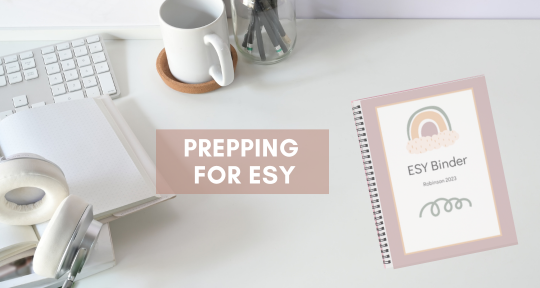The time between spring break and the end of the year flies by doesn’t it?! Before you know it, you’re making plans for ESY or your own summer vacation and let’s be honest, we kind of mentally check out of the school year. Before we call curtains on this current school year, it is important to take some time to reflect on what went well and what didn’t go well this year so that you can adjust your practice for next year. One of the best ways to go through a reflection like this as an accessible/special education teacher is to ask your paraprofessionals what they think through an EOY paraprofessional survey!
Why Should I Create a Paraprofessional Survey?
I love a good staff survey- I have a Mid-Year Staff Survey and an EOY Paraprofessional Survey in my TPT store. From experience, I find the information from these surveys to be very valuable and important for creating a supportive working environment for my paraprofessionals, and understanding better what needs to be adjusted. Doing a check in mid-year (or 2 check-ins) is important so you don’t have staff bringing up things that have been bothering them for months in their EOY evaluations (I’ve made that mistake before!) Giving staff the opportunity to tell you what is working and not working or what they would like more support in will help you course correct before you get too far into your school year.
In addition to checking in Mid-Year, it is important to also allow staff the opportunity to reflect with you about what happened this year. Whether you are a veteran accessible/special education teacher or a first year teacher, each school year is different depending on the students you have, the paraprofessionals you have, and other factors that influence the culture of your special education classroom. Collecting these answers every year will give you valuable insight that you can use as part of your mandatory teacher self-evaluation, or even just to make tweaks over the summer or for the next cohort.
I tried doing this a few ways in the past. My first few years we had a meeting before school in June to give feedback. This worked for some paraprofessionals who were very vocal and felt comfortable giving that feedback in a large group, but other paraprofessionals wouldn’t contribute at all. I needed to put on my accessible education hat on and think of a response form that would work for everyone! I tried doing anonymous paper feedback cards, but this became challenging to address the feedback because I didn’t know who was providing it and I couldn’t monitor if everyone was using the system or not. That’s how I came up with the idea of a Google Form to distribute the EOY paraprofessional survey. This solved all those problems: I was able to see if everyone responded, I could address feedback specifically to each staff member, and everyone felt comfortable responding on the computer and having some time to process their responses.
That Sounds Great, But… Where Do I Start?
Maybe you want to make your own EOY paraprofessional survey and don’t know where to begin. You want to think about this as a reverse engineering process- meaning you think about the outcome you want and work through the steps to get there starting at the end goal. For an end of year reflection, the end goals might be a couple of things:
- Understanding the classroom culture better
- Identifying your management strengths and weaknesses
- Learning what staff felt was valuable and invaluable
- Assessing the classroom systems, schedule, and processes for efficiency and value
You might pick one of two of those objectives (or all of them!) to drive the creation of the EOY paraprofessional survey. Once you pick a goal, you can brainstorm questions that will get your paraprofessionals reflecting on that topic.
Picking a Goal for Your Survey
Having trouble thinking of a goal for this survey? Think back to the beginning of the school year. What were some of the things you hoped to accomplish? Did you try something new that worked well? Can you remember something you set your mind on to improve? Did you learn anything from last year that you wanted to implement this year? Was there anything staff-management wise that you felt could go better? Did you do anything different training wise? These are the kinds of guiding questions that will help you get at what your big overarching goal for the survey should be.
Let’s do an example. If I want to assess classroom culture, I would put that as my main idea. Then, I need to come up with the different things I want staff to give me feedback on. I’m going to do a brain dump of subtopics related to my main topic. It might look like:
- Classroom culture
- Receiving feedback
- Ability to ask questions
- Time to review questions about students during the day
- Staff support each other
- Meaningfulness of tasks
- Opportunity to learn from mistakes
- Easy to find help when teacher isn’t around
- Negative feedback is presented in a respectful way
Questions to Ask in the Survey
Now that I have brainstormed the things I want my paraprofessionals to reflect on, I need to come up with questions that will get me to those answers. Note- this is not about engineering the ANSWERS you want, it is about engineering the REFLECTION you want. Asking staff a big, blank statement question like, “What worked well in the classroom this year?” will result in unfocused, sometimes scattered answers that don’t provide specific answers that allow you to take specific actions for next year. We don’t want this to be busy work- we want it to result in meaningful answers that can be acted upon!
There are several different forms the questions of your EOY paraprofessional survey could look like. Using Google Forms, it makes this process very easy. You could use a linear scale question, where participants rank their agreement with a statement on a scale of 1 to 5. Additionally, you could use a multiple choice response format. Maybe you could use an open response format. I personally don’t like using the open response questions that much because you sometimes get really detailed answers back, or sometimes you only get one or two words and the feedback isn’t as easy to analyze. If you use questions with closed-ended formats, you can easily analyze the data you collect from your staff. As an accessible/special education teacher, this should give you the warm and fuzzies!
What Are Some Examples?
I’m going to be using a linear scale for the majority of my questions in the EOY paraprofessional survey. Using the list above, my questions might look something like this:
- Receiving feedback
- I was given feedback on my performance in a timely and professional manner (1= strongly disagree, 5 = strongly agree)
- Ability to ask questions
- I felt comfortable to ask the teacher and my fellow staff questions about things I didn’t understand (1= strongly disagree, 5= strongly agree)
- Time to review questions about students during the day
- I would have liked to have more time during the day to have my questions answered about my students’ programing and behaviors (1= strongly disagree, 5=strongly agree)
- Staff support each other
- I could count on other paraprofessionals helping me out when I needed assistance (1=strongly disagree, 5=strongly agree)
- Meaningfulness of tasks
- All of the tasks I was given as part of my job were meaningful and important (1=strongly disagree, 5=strongly agree)
- If there were any tasks you felt were not meaningful, please list them here (open response)
- Opportunity to learn from mistakes
- When I didn’t get something or made a mistake, the teacher allowed me the opportunity to fix it or try again (1=strongly disagree, 5=strongly agree)
- Easy to find help when teacher isn’t around
- The teacher made information readily available when I had a question, so if she/he wasn’t here I knew where to look for answers (1=strongly disagree, 5=strongly agree)
- Which systems for providing information did you find the most helpful? What did you reference most frequently (open ended question)
- Negative feedback is presented in a respectful way
- Anytime I needed to receive negative feedback on my work performance, the teacher did it in a respectful way that did not cause embarrassment or shame (1=strongly disagree, 5=strongly agree)
As you can see, some of these questions might result in some hard feedback! However, if we are committed to doing our best for our students and our paraprofessionals, we should take this feedback for what it is- a learning opportunity. We can either choose to grow from this opportunity or have it crush us. If your responses aren’t what you thought they were, let this be an opportunity to course correct before next year and start off the year on a new page!
Final Tips for Creating an EOY Paraprofessional Survey
Once you have an outline for your questions for the EOY paraprofessional survey, you can start plugging them into a Google Form. Here are some other tips for creating this paraprofessional staff survey:
- Make every question required. This is a setting that can be turn on for each question (bottom right hand corner of the question box). This will ensure that staff can’t turn in the survey until they have answered every question.
- Don’t make the survey anonymous. If you do, you won’t be able to address feedback with staff. You might get some feedback that challenges your belief on how you run the classroom, and this survey will give you an opportunity to address it before it snowballs into a bigger problem. You can do this simply by going to Settings -> Responses -> Collect Email Addresses -> Responder input
- Include directions and a rationale at the beginning of your survey. If you don’t have the opportunity to introduce the concept of the survey as a group (because let’s be honest, who has that kind of time!) then this will serve as your justification for why staff should fill it out in the first place.
- If your survey is long, think about breaking it up into sections (bottom icon on the right hand side menu). This will visually break up the survey and put each section on a different page.
- Practice taking the survey in preview mode (eye icon in the top right menu). This will help you gauge how long it will take to complete and if you need to reword or reformat anything.
Need Extra Help?
I hope making an EOY paraprofessional survey helps you to reflect on your practice as both a teacher and a manager (because we have to wear many hats as an accessible/special education teacher!) This could easily be done in a prep period, or if you don’t have time, head over to my TPT store where I have an editable End of Year Staff Survey ready to go!

Do you have questions about how I use this data to create a better classroom? Let’s chat!



Leave a Reply